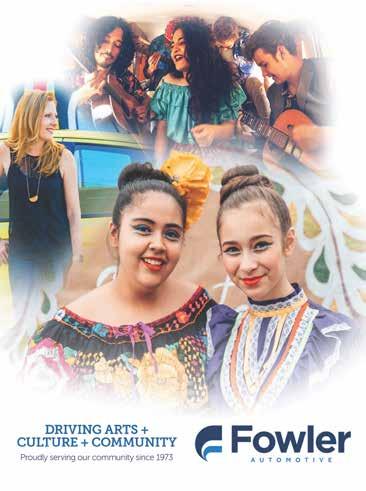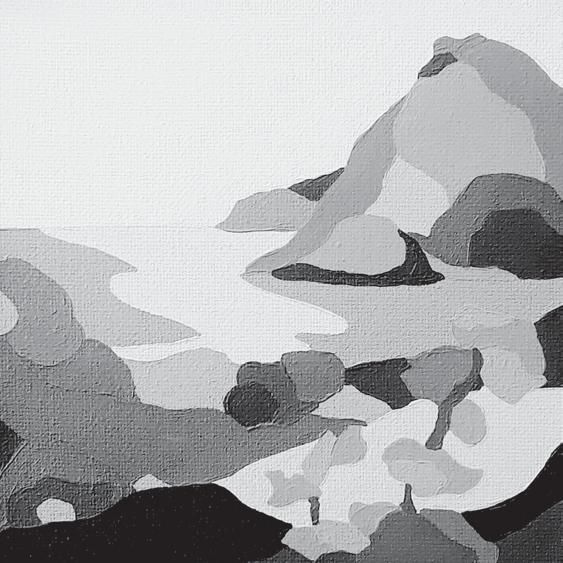
7 minute read
YIELBONZIE CHARLES JOHNSON: Are Your Questions Being Answered?
ARE YOUR QUESTIONS BEING ANSWERED? Listening to the Ancestors with Artist Yielbonzie Charles Johnson
by Ayanna Najuma
Advertisement
Yielbonzie Charles Johnson,Greenwood Rising - Variations on a Theme
Who is prepared to tell the story of the 1921 Tulsa Race Massacre, the mass graves, the destruction of property and most of all to express the fear associated with reparations? This is a question that artist, pastor, and community organizer Yielbonzie Charles Johnson continues to ask. Twenty years ago this horrific event started to creep into the newspapers and was discussed over cocktails. Believe it or not, this event was not published in Oklahoma history books and even today a curriculum is not presented to students. Johnson believes that there is a level of mystery preventing the residents in Tulsa today from being able to accept the truth surrounding this historic event.
Many African Americans settled in Tulsa prior to Oklahoma becoming a state in 1907. By 1921, because of the law and white racism, the African American residents were compelled to
develop Greenwood (aka Black Wall Street) out of necessity. It ultimately became a vibrant, wealthy, and prosperous neighborhood. May 30 - June 2, 1921 a violent white mob destroyed 35 blocks of businesses, schools, residences and churches in a segregated community. The massacre was provoked by an article published by the Tulsa Tribune and the mob received aid from the local police force.
Today, the Greenwood Art Project (GAP) has partnered with the 1921 Tulsa Race Massacre Centennial Commission to give artists grants and a platform to tell stories about the massacre and its ongoing impact in the city of Tulsa. Johnson, with his group Black Art Collaborating, is creating one such project. He is passionate about facilitating this collaborative community-driven exhibition, but he also has trepidations about the overall intentions of the Greenwood Art Project.
Johnson’s painting of a human figure in their natural state of nakedness, symbolizes the reality of the massacre. As they rise from the water a process of cleansing has been completed now symbolizing reconciliation in dissolving the discord. As a lifelong Unitarian minister who grew up in Greenwood, Johnson has counseled hundreds of people on the importance of selfreflection, self-examination, and self-realization, which is critical in addressing trauma and pain. Johnson believes that one must be able to accept and understand the essence of every chapter in this story before being able to start the healing process. He agrees with Toni Morrison’s philosophy that “The past is more infinite than the future… It’s avoiding it, deceiving ourselves about it that paralyzes growth. “
Johnson’s practice weaves storytelling and community organizing together with his paintings and sculptures. He reminds us that the ancestors are looking closely and they are always asking questions:
How will we be remembered, how will the mindset of the residents of Tulsa change and how will the City of Tulsa return Greenwood back to its original composition for those that lived there?
Is the City of Tulsa deceiving itself by believing that the 1921 Tulsa Race Massacre Centennial Commission will heal the wounds that have been lying dormant for so many years? Who is taking responsibility for this travesty and when? Where is the integrity in the process?
Johnson asks questions that may seem dangerous to pose to the power brokers doling out funding and exhibition opportunities within Tulsa.
Is the $25M being spent to build the new Greenwood Rising Museum going to help the community heal, rise up, be empowered or is that going to be multiplied by ten, with additional revenue going into the City’s coffers as people from around the world come as tourists to visit Tulsa?
Were Black contractors and consultants used to plan, construct and design the exhibits? Will Black businesses, artists, and activists with deep roots in Tulsa be in positions of power?
Has the City of Tulsa paid reparations to their families, to the family members of those who owned businesses and churches that were left devastated?
OR
Is the pain felt by Black Tulsans a spectacle for sale to the highest bidder?
Lives on the Line brings forth the collective body of work developed by Black Artist Collaborating presenting what was called “The Section line.” This line designated the end of the Greenwood district going north from Archer. The initial neighborhood of Greenwood was developed with a sense of being connected and supportive to each other socially and economically. The nooses around the necks of the figures present the elimination of life that had been taken from them so many years ago.
Johnson uses his art to connect the living to the dead, and seeks connection with others on a similar path. Johnson believed initially that participating in the Greenwood Art Project would provide an opportunity to start a conversation, to pull back the veil of pain and the wounds that people have been carrying for so long, possibly to start fresh. However, for Johnson, the GAP process is flawed at its core, and lacking in a clarity of vision. Is the project to celebrate the Greenwood community? Is the goal to acknowledge 1921 as a place in history that massacred a group of law abiding people? Will the project contribute to creating a plan of action and advance a new voice for equity and equality in Tulsa? Can the trauma and pain of the residents in Tulsa be eliminated with the $1M grant from an out-of-state philanthropist? Needless to say, it will provide an opportunity to share the talent of Tulsa’s artists, however, will the artists contributions of visual art, music, and literature repair what was broken? In some regard, it reminds one of the slave owners allowing the slaves to dance and sing on a Saturday night or go to church on Sunday even though we all know that African Americans were enslaved under the guise of Christianity and money.
“Our group understood the importance of participating in GAP, but it is too much to expect us to take on this level of responsibility for the psychologically and emotionally wounded,” said Johnson. Why are artists being asked to work as healers, when the massacre victims and their descendents are demanding reparations for what was stolen from them?
Johnson’s ceramic mask shows the transformation of one’s spirit, the channeling and description of the man’s soul. Johnson reminds us in this piece that we can rush to reconciliation without the grief. As we examine the negative, the pain and the trauma of the massacre, we must also strive and desire for transformation. We must each look back to our deathbed and then wake up after the (continued to page 24)

Yielbonzie Charles, Beneath the Veil, ceramic mask
(continued from page 23)

Yielbonzie Charles Johnson, Born of Fire Yielbonzie Charles Johnson, Lives on the Line


massacre. We cannot make Tulsa a tourist destination or a place where young people are recruited to add value to Tulsa’s brand of expansion in the world. As you look at the eyes of the mask we must also remember that the Greenwood community was a part of the intimacy of one’s self.
Johnson leaves us with one final thought, “Art is a means of communicating that is hard to express in language, symbolism or images. It is all your individual interpretation.”
He has asked a series of questions, as a resident of Tulsa, as a spiritual person, and as an artist—now what do you think?
Yielbonzie Charles Johnson and Black Art Collaborating will present their exhibition Lives on the Line April 4-June 30 at Church of The Restoration, 1314 N. Greenwood Ave., Tulsa, OK 74106-4854 n
Ayanna Najuma is an art advisor, curator and journalist. She is a civil rights icon and sat in at the age of seven at Katz Drug Store in Oklahoma City, two years before Greensboro, North Carolina. She is the founder of I HAVE A VOICE NOW! a movement to educate and empower youth on the importance of advocacy and activism and WHAT LIES BETWEEN US with Ayanna Najuma, a conversational platform on social justice.

REMOVAL (POETRY AND PHOTOGRAPHY) Murals, Street Art, and Graffiti around Greenwood
by Alexxus Browning

Alexxus Browning, BLM Mural - Tulsa OK Series
$36,000,000 Restoration of the Tulsa Club Hotel
—Pete Patel “Tulsa World”
found bats T h e y
in the building
They found water but the floors intact
less The home-
made it
a
brella torn um-
They burned it
d o w n without a match
They rubbed their
hands together
one winter &
the
w h o l e world caught fire
—Clemonce Heard










